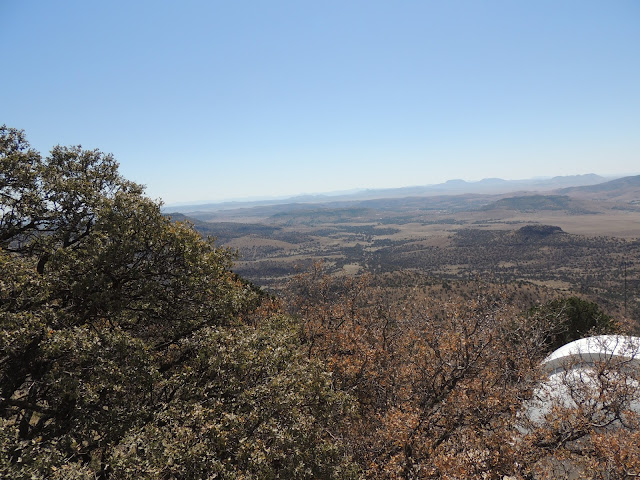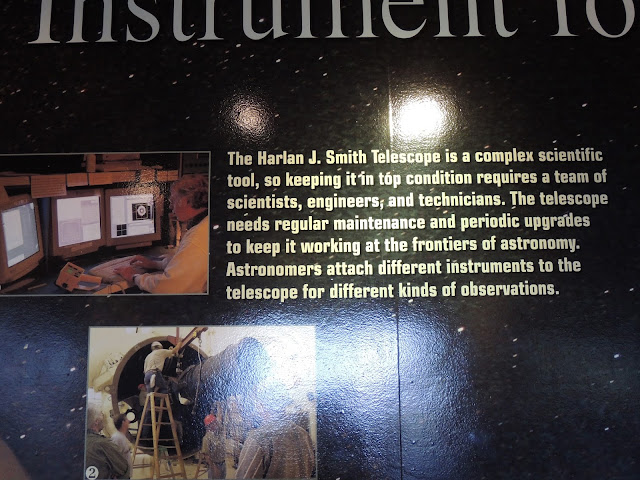McDonald Observatory
Fort Davis, TX
Marfa, TX
Looks like Abby will be comfortable when we are gone. She doesn't freak out anymore when you take her photo, but I think she just gave me the stink eye.
On the way to Marfa, TX where we stayed, we came upon this thing. We weren't sure what it was, but thought it might be some kind of weather balloon. Found this on the interweb.... It is a Tethered Aerostat Radar System (TARS) and there are 8 of these and 6 are located along the US-Mexico border from Yuma AZ to Rio Grande City TX. They are used to monitor the border for drug trafficking..
https://www.cbp.gov/frontline/frontline-november-aerostats
www.govtech.com/.../Photo-of-the-Week-The-Tethered-Aerostat-Radar-System-Keep
https://fas.org/nuke/guide/usa/airdef/tars.htm
Marfa, TX Our RV site. It's an interesting little town, very eclectic. Our site was pretty barren.
That's our shade tree next to the RV. It didn't help much.
On the way to the McDonald Observatory
We're here.
We watched a presentation.
The enlarged photo is of "granules", Cells of hot gas circulating in the Sun. Granules are the size of Texas to the size of Alaska
A Sunspot Anatomy..
The innermost black area is called the "Umbra" (Latin for shadow)...It's about 1800 degrees F cooler than the Sun's surface temp of 9950 degrees F. It's magnetic field is up to 6000 times stronger than Earth's.
The next shaded part is the "Penumbra" (Latin for almost shadow)...they are flux tubes where magnetism leaks to the rest of the solar surface.
Within the field of "granules" are "lanes" where cool gases circulate back to the interior, and "bright points" which are tiny areas heated by intense magnetic fields.
Cool Picture, I don't remember what it was.

These are called filaments. Filaments are formed in magnetic loops that hold relatively cool, dense gas suspended above the surface of the Sun
A solar eclipse
This explains the following photo. 2017 is a quiet time for solar activity.
Quiet Sun
StarDate:
April 5, 2017
The Sun goes through an 11-year magnetic cycle. At the cycle’s peak, the Sun produces large numbers of dark sunspots and powerful explosions known as solar flares. At the cycle’s low point, the Sun is quiet, with little activity on its surface.
But no two cycles are alike. Some are especially active, while others are unusually quiet. And some of the quietest yet identified may have happened 7500 years ago.
An international team of scientists found this quiet period by studying tree rings. When the Sun is quiet, it allows more cosmic rays to enter the solar system. These particles come from exploding stars and other powerful sources. When they hit Earth’s atmosphere, they trigger showers of other particles. And when those particles reach the ground, they can alter atoms.
In particular, they can change carbon atoms to a radioactive form known as carbon-14. So the ratio of normal carbon to carbon-14 found in tree rings varies based on the amount of solar activity.
The new study found some of the highest levels of carbon-14 yet discovered in the rings of bristlecone pines from the White Mountains of California. The levels were especially high from about 5490 to 5460 BC.
That could mean that the Sun was especially quiet during that period. If that’s the case, then almost no sunspots would have mottled its surface. That would have allowed the cosmic rays to flood into the solar system and hit Earth — leaving traces in ancient trees.
https://www.stardate.org
First stop, great view.
Later, we go to the that sphere in the distance.
Zoomed in
The Harlan J. Smith Telescope was dedicated in 1968 and Named after the first director of the McDonald Observatory.
There are several circular panels, in this photo you can see two, that can be removed to redirect the focus of the telescope.
The telescope is mounted at a fixed angle that cannot be altered. It's mounted on a floor that can rotate to the direction they want to see, then the dome above rotates the door to line up with the telescope. When the dome is moving, it's a real weird feeling that you are moving too, but you're not.
This next telescope is number 4 or 5, in size and technology, in the world. The Hobby-Eberly Telescope. Here's a news release from a couple years ago.
Upgraded Hobby-Eberly Telescope Sees First Light
2 November 2015
After several years and a massive team effort, one of the world’s largest telescopes has opened its giant eye again. The Hobby-Eberly Telescope (HET) at The University of Texas at Austin’s McDonald Observatory has completed a $25 million upgrade and, now using more of its primary mirror, has achieved “first light” as the world’s third-largest optical telescope.
“This upgrade makes HET the most powerful wide-field spectroscopic telescope worldwide, and we expect unique scientific discoveries from it,” observatory director Taft Armandroff said.
The new HET made its first image on July 29. After extensive testing and fine-tuning, the team reports that image quality meets specifications — sharp enough to resolve features one mile across on the surface of the Moon (or in astronomical terms, a resolution of 0.9 arcseconds.)
Spurred by the HET collaboration’s desire to do big science projects, including the forthcoming Hobby-Eberly Telescope Dark Energy Experiment (HETDEX), the upgrade was a major undertaking that includes new optics, new mechanics, and new software. Today, HET is essentially a new telescope — only its primary mirror remains unchanged.
What makes the new HET great? One major factor is the new Harold C. Simmons Dark Energy Optical System. This set of optics sits above the telescope’s main mirror, in the location usually occupied by a secondary mirror.
McDonald Observatory chief scientist Phillip MacQueen designed the system. He explained that the Simmons System, informally called a “corrector,” is a complex set of optics, including four mirrors, that achieves two key tasks.
First, it brings light from the primary mirror into sharp focus. Because HET’s primary mirror is spherical rather than parabolic, it does not focus light into a sharp image. To make sharp images, the primary mirror needs to feed light into a corrector before it is fed into scientific instruments.
Second, the Simmons System allows good images from all parts of the telescope’s greatly enlarged field of view. The telescope’s field of view has increased by 120 times, and is 70% of the diameter of the full Moon (that is, 22 arcminutes or one-third of a degree).
Research Associate Hanshin Lee managed a nearly seven-year process by The University of Arizona College of Optical Sciences to build and test the $6 million Simmons Optical System. It was a tough process to verify the optics and ensure they were set up properly.
The work consisted of shaping the four mirrors (three 1-meter mirrors and one 0.25-meter mirror) to exacting specifications and testing those shapes, applying a specialized reflective coating, putting them together into a single package, and aligning them to high accuracy.
Once the Simmons System was built, transporting the 2-ton assembly safely from Tucson to McDonald Observatory in West Texas was an undertaking fraught with danger. Its optics were so finely balanced that hitting any pothole could spell a problem. It made the 500-mile trip overnight, going 45 miles per hour, with a police escort and arrived May 28. Later testing verified that nothing had moved in the process — the optics were still aligned within a fraction of the width of a human hair.
Lee said that throughout the difficult building and testing process “our staff was really fantastic in stepping up — while solving problems, they showed a lot of creativity and conviction that they could do it,” noting that it took many people with different talents to make the project a success.
The Simmons System is “one of the most complex optical systems ever deployed in astronomy,” said Gary Hill, McDonald Observatory’s chief astronomer and principal investigator for HETDEX.
Because it allows more of HET’s 10-meter by 11-meter mirror to be used, it makes HET a larger telescope. The mirror’s effective size has increased from 9.2 meters to 10 meters. This means that HET is now tied for the world’s third-largest optical telescope.
The telescope also features a new tracker that supports the Simmons System (and a suite of instruments to ensure its alignment to extremely high precision) as it moves across the primary mirror tracking cosmic targets across the sky. The new tracker was built by The University of Texas at Austin Center for Electromechanics. A McDonald Observatory team led by Niv Drory developed HET’s entirely new control system.
The upgraded telescope is now able to track and guide on cosmic targets. The next step for the HET team is to complete commissioning of the telescope. Then the team will move on to commissioning HET’s three new science instruments.
Larry Ramsey, chairman of the HET Board of Directors and professor at Penn State, remarked, “The revitalized HET will contribute to many areas of science — not only the study of dark energy; but the nature of dark matter; the first stars in the universe; starburst galaxies; massive black holes; and to the discovery, confirmation, and characterization of extrasolar planets.”
The Hobby-Eberly Telescope came online in 1997. It is a partnership between The University of Texas at Austin, The Pennsylvania State University, Georg-August-Universität Göttingen, and Ludwig-Maximilians-Universität München. The HET upgrade was funded by a combination of federal, state, and private sources.
It can "float" on hover pads. The black hose sends air into an inner tube-like disc with tiny holes in it. It functions like an air hockey table to lift the scope ever so slightly on a bed of air, so it can be moved easily.
Tools of the trade
George T. Abell Gallery was closed for renovation.
A giant Magellan Telescope
http://mcdonaldobservatory.org/
Marfa, TX Cool Buildings on the Square
http://www.visitmarfa.com/
The Original Hotel Paisano. A National Historical Landmark
60 Minutes calls it "The capital of Quirkiness
http://www.cbsnews.com/news/marfa-texas-the-capital-of-quirkiness-04-08-2013/































































No comments:
Post a Comment